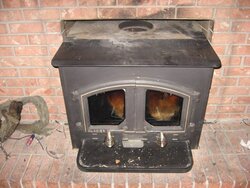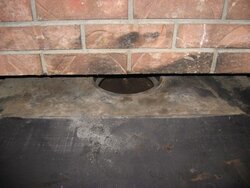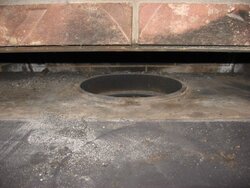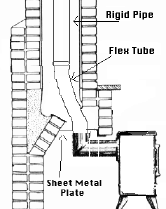Sharing my situation and looking for some suggestions from some educated folks:
I bought a house in June and was pretty excited about the wood burner (Glacier Bay) that came with it. The other day I got on the roof with my sweep and found the external masonry chimney wasn't lined. I understand this isn't a good situation. I checked for a draft and was getting warm air, so I figured things were kosher. Fired up some pine out of the Med. Bow forest and got some coals going. She didn't want to take off right away; it seemed I wasn't getting much air supply. I had to leave the doors slightly cracked to get good flame (starting to worry). I got a good base of coals and started rolling on small locust lengths. Over the course of about about two hours, the house smelled like smoke, but wasn't visible (starting to worry a little more). I tried to tell myself it was due to me opening and closing the doors nonstop to keep the fire going. Ran locust the rest of the afternoon and couldn't get the hearth room above 65 no matter how hard I tried(freaking out). Let it cool over night and pulled off the trim shield in the morning. Found the following situation: Stove had no pipe exiting the top; stove was sitting so close to the front of the hearth, the front of the hearth ceiling was covering about three inches of the eight inch chimney flange. I'm no expert, but this seems like a pretty shotty job. I've read many forum postings from the site on where to go from here. I am a handyman, but would feel more comfortable having a pro make this pisspoor installation and efficient one.
Questions:
1) Who can I contact to have this repair/install done?
2) How much should I expect to pay for a liner, flue plate, and hardware?
3) What kind of labor is going to take?
4) This stove was made in 1979. I've been told if it's moved or removed, it could possibly be illegal to reinstall because it is currently "grandfathered" and wouldn't meet code if reinstalled (making the unit illegal). Is this true?
5) Where to go from here?
Thanks
I bought a house in June and was pretty excited about the wood burner (Glacier Bay) that came with it. The other day I got on the roof with my sweep and found the external masonry chimney wasn't lined. I understand this isn't a good situation. I checked for a draft and was getting warm air, so I figured things were kosher. Fired up some pine out of the Med. Bow forest and got some coals going. She didn't want to take off right away; it seemed I wasn't getting much air supply. I had to leave the doors slightly cracked to get good flame (starting to worry). I got a good base of coals and started rolling on small locust lengths. Over the course of about about two hours, the house smelled like smoke, but wasn't visible (starting to worry a little more). I tried to tell myself it was due to me opening and closing the doors nonstop to keep the fire going. Ran locust the rest of the afternoon and couldn't get the hearth room above 65 no matter how hard I tried(freaking out). Let it cool over night and pulled off the trim shield in the morning. Found the following situation: Stove had no pipe exiting the top; stove was sitting so close to the front of the hearth, the front of the hearth ceiling was covering about three inches of the eight inch chimney flange. I'm no expert, but this seems like a pretty shotty job. I've read many forum postings from the site on where to go from here. I am a handyman, but would feel more comfortable having a pro make this pisspoor installation and efficient one.
Questions:
1) Who can I contact to have this repair/install done?
2) How much should I expect to pay for a liner, flue plate, and hardware?
3) What kind of labor is going to take?
4) This stove was made in 1979. I've been told if it's moved or removed, it could possibly be illegal to reinstall because it is currently "grandfathered" and wouldn't meet code if reinstalled (making the unit illegal). Is this true?
5) Where to go from here?
Thanks





